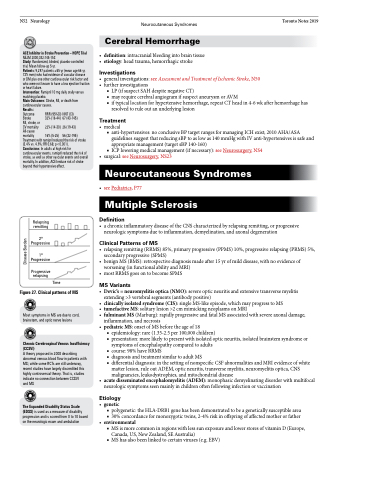Page 794 - TNFlipTest
P. 794
N52 Neurology
Neurocutaneous Syndromes
Toronto Notes 2019
ACE Inhibitor in Stroke Prevention – HOPE Trial
Cerebral Hemorrhage
• definition:intracranialbleedingintobraintissue • etiology:headtrauma,hemorrhagicstroke
Investigations
• generalinvestigations:seeAssessmentandTreatmentofIschemicStroke,N50 • furtherinvestigations
■ LP (if suspect SAH despite negative CT)
■ may require cerebral angiogram if suspect aneurysm or AVM
■ if typical location for hypertensive hemorrhage, repeat CT head in 4-6 wk after hemorrhage has
resolved to rule out an underlying lesion
Treatment
• medical
■ anti-hypertensives: no conclusive BP target ranges for managing ICH exist; 2010 AHA/ASA
guidelines suggest that reducing sBP to as low as 140 mmHg with IV anti-hypertensives is safe and
appropriate management (target sBP 140-160)
■ ICP lowering medical management (if necessary): see Neurosurgery, NS4
• surgical:seeNeurosurgery,NS23 Neurocutaneous Syndromes
• seePediatrics,P77
Multiple Sclerosis
Definition
• a chronic inflammatory disease of the CNS characterized by relapsing remitting, or progressive neurologic symptoms due to inflammation, demyelination, and axonal degeneration
Clinical Patterns of MS
• relapsingremitting(RRMS)85%,primaryprogressive(PPMS)10%,progressiverelapsing(PRMS)5%, secondary progressive (SPMS)
• benignMS(BMS):retrospectivediagnosismadeafter15yrofmilddisease,withnoevidenceof worsening (in functional ability and MRI)
• mostRRMSgoesontobecomeSPMS
MS Variants
• Devic’s=neuromyelitisoptica(NMO):severeopticneuritisandextensivetransversemyelitis extending >3 vertebral segments (antibody positive)
• clinicallyisolatedsyndrome(CIS):singleMS-likeepisode,whichmayprogresstoMS
• tumefactiveMS:solitarylesion>2cmmimickingneoplasmsonMRI
• fulminant MS (Marburg): rapidly progressive and fatal MS associated with severe axonal damage,
inflammation, and necrosis
• pediatricMS:onsetofMSbeforetheageof18
■ epidemiology: rare (1.35-2.5 per 100,000 children)
■ presentation: more likely to present with isolated optic neuritis, isolated brainstem syndrome or
symptoms of encephalopathy compared to adults
■ course: 98% have RRMS
■ diagnosis and treatment similar to adult MS
■ differential diagnosis: in the setting of nonspecific CSF abnormalities and MRI evidence of white
matter lesion, rule out ADEM, optic neuritis, transverse myelitis, neuromyelitis optica, CNS
malignancies, leukodystrophies, and mitochondrial disease
• acutedisseminatedencephalomyelitis(ADEM):monophasicdemyelinatingdisorderwithmultifocal
neurologic symptoms seen mainly in children often following infection or vaccination
Etiology
• genetic
■ polygenetic: the HLA-DRB1 gene has been demonstrated to be a genetically susceptible area ■ 30% concordance for monozygotic twins, 2-4% risk in offspring of affected mother or father
• environmental
■ MS is more common in regions with less sun exposure and lower stores of vitamin D (Europe,
Canada, US, New Zealand, SE Australia)
■ MS has also been linked to certain viruses (e.g. EBV)
NEJM 2000;342:145-153
Study: Randomized, blinded, placebo-controlled trial. Mean follow-up 5 yr.
Patients: 9,297 patients ≥55 yr (mean age 66 yr, 73% men) who had evidence of vascular disease
or DM plus one other cardiovascular risk factor and who were not known to have a low ejection fraction or heart failure.
Intervention: Ramipril 10 mg daily orally versus matching placebo.
Main Outcomes: Stroke, MI, or death from cardiovascular causes.
Results:
Outcome
Stroke
MI, stroke, or
CVmortality
All-cause
mortality
Treatment with ramipril reduced the risk of stroke (3.4% vs. 4.9%; RR 0.68; p<0.001).
Conclusions: In adults at high risk for cardiovascular events, ramipril reduced the risk of stroke, as well as other vascular events and overall mortality. In addition, ACEI reduce risk of stroke beyond their hypertensive effect.
Relapsing remitting
2o Progressive
1o Progressive
Progressive relapsing
Time
Figure 27. Clinical patterns of MS
Most symptoms in MS are due to cord, brainstem, and optic nerve lesions
Chronic Cerebrospinal Venous Insufficiency (CCSVI)
A theory proposed in 2008 describing abnormal venous blood flow in patients with MS; while some RCTs are still underway, recent studies have largely discredited this highly controversial theory. That is, studies indicate no connection between CCSVI
and MS
The Expanded Disability Status Scale (EDSS) is used as a measure of disability progression and is scored from 0 to 10 based on the neurologic exam and ambulation
RRR (95%CI) NNT (CI) 32%(16-44) 67(43-145)
22%(14-30) 26(19-43) 16% (5-25) 56 (32-195)
Disease Burden


